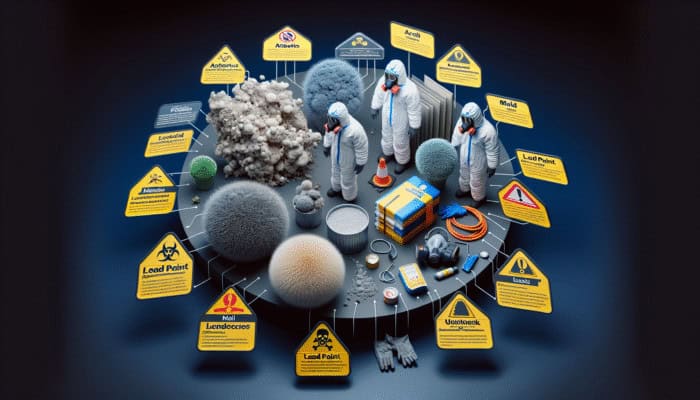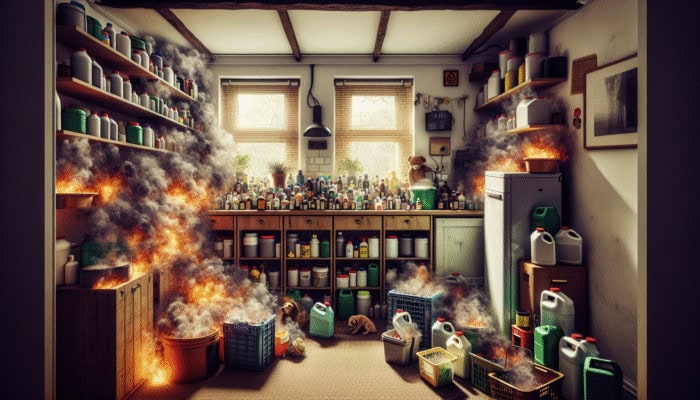Comprehensive Guide to Understanding UK Hazardous Waste Regulations
Essential Legislation Governing Hazardous Waste

The framework of managing hazardous waste in the UK is defined by a comprehensive array of legislation aimed at safeguarding both public health and the environment. The primary piece of legislation is the Environmental Protection Act 1990, which establishes the groundwork for the classification, handling, and disposal of hazardous waste materials. Complementing this legislation are the Hazardous Waste Regulations 2005, which specify the detailed procedures for managing hazardous waste to ensure that disposal methods are not only compliant but also prioritise safety. The regulatory framework is additionally strengthened by retained EU regulations post-Brexit, such as the Waste Framework Directive, which enforces a waste hierarchy that prioritises prevention, reuse, and recycling of waste materials.
It is essential for homeowners, landlords, and businesses to grasp the implications of these laws. Non-compliance can result in severe penalties, including substantial fines and the possibility of criminal charges. A thorough understanding of what constitutes hazardous waste—substances deemed toxic, corrosive, or harmful to human health and the environment—is crucial for anyone engaged in property management or renovation projects.
Moreover, these regulations mandate that any hazardous waste generated must be accurately identified, securely stored, and disposed of correctly. This entails diligent record-keeping and, in certain cases, the necessity of obtaining a waste carrier’s licence for the transportation of hazardous materials. By comprehending the legislative requirements, individuals and organisations can contribute to a safer community while also minimising their ecological footprint.
Key Regulatory Bodies Overseeing Hazardous Waste Management
The enforcement of hazardous waste regulations across the UK is overseen by various regulatory bodies, each playing a significant role in ensuring compliance with environmental laws. At the national level, the Environment Agency (EA) in England, the Natural Resources Body for Wales (NRW), the Scottish Environment Protection Agency (SEPA), and the Department for Agriculture, Environment and Rural Affairs (DAERA) in Northern Ireland are tasked with monitoring and enforcing laws related to hazardous waste management.
These agencies are responsible for the registration of hazardous waste and ensuring that all operators comply with established standards. They also provide valuable guidance and support for businesses and homeowners navigating the complexities of hazardous waste management. Their resources include informative publications, user-friendly online tools for waste classification, and designated contact points for direct assistance.
Furthermore, local councils play a crucial role in managing waste disposal and collection issues, acting as the first point of contact for residents. Many councils have dedicated waste management teams that can advise on local regulations, collection schedules, and disposal options for hazardous materials. Understanding these regulatory bodies and their functions empowers individuals to seek informed advice and support when dealing with hazardous waste.
Understanding Compliance Requirements for Hazardous Waste
To comply with UK hazardous waste laws, a well-defined approach is essential, beginning with a clear understanding of what constitutes hazardous waste. Homeowners must undertake a thorough assessment of materials within their property. Items such as old paint, batteries, and electrical appliances may contain hazardous substances necessitating special handling.
Once hazardous materials are identified, it is crucial for homeowners to ensure these items are stored correctly in designated containers that prevent leakage and exposure. Clearly labelling these containers is equally important to avoid accidental misuse. The subsequent step involves documenting the quantity and type of hazardous waste produced, critical for compliance reporting.
If disposal becomes necessary, homeowners must arrange for a licensed waste carrier to transport the hazardous waste to an appropriate facility. Regulations stipulate that all waste must be accompanied by a waste transfer note, detailing the type of waste, its origin, and how it will be treated. This documentation is vital for demonstrating compliance and ensuring the correct handling of hazardous waste.
Finally, it is advisable to engage in regular training and updates regarding compliance requirements. Homeowners should remain informed about any changes in regulations and best practices for hazardous waste management to avoid penalties and positively contribute to environmental protection.
Identifying Hazardous Materials in UK Homes

Common Household Hazards to Be Aware Of
Numerous everyday items found in UK homes may contain hazardous substances, posing significant risks to health and the environment. Common household hazards encompass cleaning products, paints, solvents, and pesticides, all of which can contain harmful chemicals if mishandled. For example, products containing bleach or ammonia can produce toxic fumes when mixed, underscoring the need for careful storage and usage practices.
Another significant hazard frequently overlooked is asbestos, which is commonly found in homes constructed before 2000. Materials containing asbestos may include insulation, ceiling tiles, and floor coverings. Recognising these materials is essential, as improper handling during renovations can release dangerous fibres into the air, leading to serious health repercussions.
Batteries, particularly older models, pose hazards due to their lead and acid content. Improper disposal of batteries can result in soil and water contamination. Similarly, electronic waste, such as obsolete televisions or computers, can contain heavy metals like mercury and cadmium, which are harmful to both human health and the environment.
Raising awareness and educating oneself about these common household hazards is essential. Homeowners should regularly review and update their understanding of what constitutes hazardous waste and take proactive measures to manage these materials safely. This may involve reaching out to local councils for disposal options or seeking advice from waste management professionals to ensure compliance with regulations.
Effective Asbestos Detection Techniques
Identifying asbestos in UK homes is a critical task, especially for properties built prior to 2000. Homeowners must remain vigilant, as asbestos was widely utilised in construction due to its fire-resistant properties. Common areas to inspect include loft insulation, ceiling tiles, textured wall coatings, and certain types of flooring.
If there is any uncertainty regarding the presence of asbestos, it is vital not to disturb the materials. Disturbing asbestos can release fibres into the air, which can then be inhaled, leading to severe health problems such as asbestosis and mesothelioma. The safest course of action is to seek professional asbestos surveying services. Qualified experts can conduct thorough inspections and, if required, carry out sampling and analysis of suspected materials.
For those who enjoy DIY projects, understanding how to recognise potential asbestos-containing materials can help prevent dangerous exposure. Homeowners should familiarise themselves with the characteristics of asbestos products, including their colour and texture. However, given the associated risks, it is always advisable to err on the side of caution and consult professionals when in doubt.
Moreover, the government provides guidelines and resources on asbestos management, assisting homeowners in understanding their responsibilities regarding detection and removal. By taking these precautions, individuals can protect their health and that of their families while ensuring compliance with hazardous waste regulations.
Risks Associated with Improper Chemical Storage

The safe storage of chemicals commonly found in UK homes is crucial to preventing accidents and ensuring compliance with hazardous waste regulations. Many everyday household items—cleaning products, paints, and garden pesticides—contain chemicals that can pose risks if not stored correctly. Ideally, these substances should be kept in a cool, dry location away from direct sunlight and out of reach of children and pets.
Utilising original containers with clear labelling is vital. Labels should include all safety information, such as hazards, usage instructions, and disposal methods. Mixing different chemicals can be particularly dangerous; for example, combining bleach with ammonia results in the release of toxic gases.
Homeowners should also consider implementing secondary containment methods. This involves placing hazardous materials within a secondary container, such as a plastic bin, to prevent spills and leaks. Regularly checking the expiry dates on chemical products can also help prevent the accumulation of hazardous waste, reducing the risk of accidents.
Educating all household members about the dangers associated with improper chemical storage and disposal is essential. By fostering a culture of safety and awareness, families can significantly reduce the risks related to hazardous materials in their home environment. Additionally, local authorities often provide guidelines on the safe storage and disposal of household chemicals, offering valuable resources to assist homeowners in maintaining a secure living space.
Essential Tools for Effectively Managing Hazardous Waste
Importance of Protective Equipment
When managing hazardous waste, the utilisation of appropriate protective equipment is imperative. The right gear ensures safety by minimising exposure to harmful substances. Homeowners and professionals alike should invest in personal protective equipment (PPE) that includes gloves, goggles, masks, and suitable protective clothing.
Chemical-resistant gloves are essential when handling substances like solvents or cleaners. Options made from latex or nitrile are common and should be selected based on the specific chemicals involved. Eye protection is equally critical, especially when working with materials that could splash or emit harmful fumes. Safety goggles or face shields provide an effective barrier against dangerous chemicals and potential debris.
Respiratory protection is necessary in situations involving dust, vapours, or fumes. Masks should be selected based on the level of exposure risk, with choices ranging from basic surgical masks to advanced respirators that filter out specific hazardous particles. Furthermore, if asbestos is suspected, specialised respiratory protection must be employed.
Lastly, protective clothing—such as coveralls—can prevent skin contact with hazardous materials. This gear should be durable and easily washable to ensure safe reuse. When handling hazardous waste, prioritising safety and ensuring that all equipment is worn correctly is crucial. Providing proper training on the use of PPE enhances safety measures, ensuring that everyone understands how to protect themselves effectively.
Effective Containment Solutions for Hazardous Waste
Implementing effective containment solutions is vital for the safe management of hazardous waste. Various containers are specifically designed for hazardous materials, each tailored to meet specific needs based on the type of waste being handled. Using the correct type of container not only enhances safety but also ensures compliance with UK regulations.
For liquid hazardous waste, UN-approved containers with appropriate labels are essential. These containers are engineered to prevent leaks and spills, thereby protecting both the environment and public health. Solid hazardous waste, such as old paint cans or electronic waste, requires robust containers capable of withstanding pressure and preventing contamination.
Additionally, secondary containment measures, such as spill pallets, provide an extra layer of security. These pallets are designed to hold any accidental spills, ensuring that hazardous materials do not leak into the environment. Proper storage practices, including regular inspections of containers for wear and tear, are crucial for maintaining safety.
In community settings, municipalities often provide designated drop-off points for hazardous waste. These facilities are equipped to handle various types of waste and ensure proper containment until disposal. Residents should take advantage of these resources to ensure their hazardous waste is contained safely and disposed of responsibly.
Implementing effective containment solutions not only protects individuals and families but also contributes to broader environmental safety. By recognising the importance of proper containment and utilising available resources, homeowners can play a proactive role in hazardous waste management.
Utilising Disposal Kits for Hazardous Waste
In the UK, disposal kits for hazardous waste equip homeowners and businesses with the necessary tools for the safe and compliant management of hazardous materials. These kits vary in content to cater to different types of waste, including chemical, electronic, and biological hazards.
A typical chemical disposal kit includes absorbent materials, gloves, and disposal bags. These kits enable users to effectively manage spills or leaks while minimising exposure to harmful substances. For instance, in the event of a household cleaner spill, the absorbent materials can contain the spill efficiently, preventing further hazards.
Electronic waste disposal kits often come equipped with protective gear and instructions for safe disassembly and recycling. Given the hazardous materials present in electronics, such as lead and mercury, utilising these kits helps ensure that these items are disposed of correctly, thereby minimising environmental impact.
Additionally, local councils may offer specialised disposal kits that align with regional regulations. Homeowners should inquire about available resources, as these kits often include guidance on how to dispose of hazardous waste safely and legally.
By equipping themselves with the right disposal kits, residents can make significant strides towards responsible hazardous waste management. These tools not only enhance safety during disposal but also empower individuals to positively contribute to environmental protection by effectively managing hazardous materials.
The Importance of Training Programmes in Hazardous Waste Management
Training programmes focused on hazardous waste management are essential for anyone involved in handling hazardous materials. These courses furnish critical knowledge regarding the regulations, safe handling practices, and compliance requirements that are specific to the UK.
Many organisations offer training tailored to various levels, ranging from basic awareness courses designed for homeowners to in-depth training for professionals in construction or waste management. Participants learn how to identify hazardous materials, comprehend legal obligations, and implement safe disposal practices.
Certification is often a key component of these training programmes, enhancing credibility and recognising the individual’s expertise. For businesses, investing in employee training can lead to improved workplace safety and compliance, thereby reducing the risk of accidents and legal complications.
As regulations and best practices continue to evolve, ongoing education becomes increasingly vital. Regular refresher courses ensure that individuals remain informed about the latest developments in hazardous waste management. Many training providers also offer e-learning options, facilitating access to necessary training without disrupting individuals’ schedules.
By prioritising training and education in hazardous waste management, both homeowners and professionals can create a culture of safety that benefits all stakeholders. Equipped with the right knowledge, individuals can manage hazardous materials confidently and responsibly, significantly reducing environmental and health risks.
Understanding the Importance of Regulatory Compliance
Regulatory compliance in hazardous waste management is a critical aspect of ensuring safety and legality within the UK. Understanding the specific laws and regulations governing hazardous waste is essential for homeowners, businesses, and waste management professionals. Non-compliance can lead to severe repercussions, including fines, legal action, and significant environmental risks.
Key regulations include the Hazardous Waste Regulations 2005, which mandate the proper classification, management, and disposal of hazardous materials. Homeowners must be aware of what constitutes hazardous waste, which encompasses a broad range of materials, from old batteries to specific household cleaners.
Documentation is pivotal for regulatory compliance. Homeowners and businesses must maintain accurate records of hazardous materials, including types, quantities, and disposal methods. This documentation not only supports compliance but also aids in tracking waste management practices over time.
Engaging with licensed waste carriers for the transportation of hazardous waste is another critical compliance requirement. It is essential to ensure that these carriers adhere to all legal protocols regarding waste handling, disposal, and record-keeping. Homeowners should consistently request copies of waste transfer notes, which serve as evidence of proper disposal.
Staying informed about changes in regulations is essential. The UK government and environmental agencies frequently update guidelines, and proactive engagement with these resources can equip individuals with the knowledge needed to maintain compliance. By prioritising regulatory compliance, homeowners and businesses can contribute to a safer environment while avoiding potential legal issues.
Safe Removal Techniques for UK House Clearance
Professional Asbestos Removal Procedures
The process of asbestos removal is paramount in ensuring the safety of homes constructed before the year 2000. Given the severe health risks associated with asbestos exposure, including lung cancer and other respiratory diseases, it is essential to approach this task with caution and expertise.
The initial step in the asbestos removal process involves conducting a thorough inspection of the property. Homeowners should engage a qualified asbestos surveyor to assess materials suspected of containing asbestos. If asbestos is confirmed, a detailed removal plan should be formulated, outlining the methods and safety measures to be employed.
Professional removal is highly recommended due to the dangers associated with incorrect handling. Trained specialists possess the necessary protective gear and tools to safely remove asbestos materials. During the removal process, containment measures must be implemented to prevent the release of asbestos fibres into the air. This includes sealing off the work area and using specialised equipment to minimise dust.
Once materials have been safely removed, proper disposal must occur in accordance with UK regulations. Asbestos waste must be taken to a licensed facility that meets stringent disposal criteria. Homeowners should always ensure that a waste transfer note accompanies the removed materials, documenting their disposal.
Post-removal, conducting air quality assessments can confirm that all asbestos fibres have been adequately eliminated from the environment. By meticulously following these procedures and enlisting professional assistance, homeowners can safeguard their health and that of future occupants.
Neutralisation Techniques for Hazardous Chemicals
Neutralising hazardous chemicals is a vital aspect of safe waste management within UK households. Many everyday products, such as cleaners, paints, and solvents, can pose risks if not handled and disposed of properly. Neutralisation is the process of rendering these chemicals less harmful or safe for disposal.
Before commencing the neutralisation process, it is essential to identify the specific chemical and its properties, as different substances require different neutralising agents. For instance, acidic cleaners can typically be neutralised with a base like baking soda, while alkaline substances may require an acid. Always refer to the product’s safety data sheet for guidance on neutralisation methods.
During the neutralisation process, protective equipment—including gloves and goggles—should always be worn to minimise exposure to harmful substances. Conducting the neutralisation outdoors or in a well-ventilated area is advisable, as reactions can produce fumes or heat.
After neutralisation, the resulting compounds can often be safely disposed of as regular waste, depending on local regulations. However, it is crucial to confirm with local waste management authorities that the neutralised material is indeed safe for standard disposal.
Educational resources and training on chemical neutralisation are available through local councils and environmental agencies. Homeowners should take advantage of these resources to ensure safe practices are adhered to in their households. By understanding and implementing proper neutralisation techniques, families can contribute to safer living environments and mitigate the risks associated with hazardous waste.
Effective Waste Segregation Practices
Waste segregation is a cornerstone of effective hazardous waste management. Sorting hazardous materials from regular household waste ensures that dangerous substances are dealt with appropriately, preventing contamination and promoting safety. This practice becomes even more crucial during house clearances, where various materials may be mixed together.
Homeowners should begin by identifying and categorising their waste types. Common categories include electronic waste, chemicals, batteries, and general household items. Each category may have specific disposal requirements, making it essential to understand these for compliance with UK regulations.
Using clearly labelled bins for different waste types can facilitate effective segregation. For example, creating separate containers for chemicals, recyclable materials, and general waste helps prevent accidental mixing. Regularly educating all household members about the importance of segregation can foster a culture of safety, ensuring everyone participates in the process.
Additionally, many local councils offer specific collection services for hazardous waste. Homeowners are encouraged to utilise these services, which often include separate collection days or drop-off points for hazardous materials. Adhering to these guidelines not only ensures compliance but also contributes to a healthier community by preventing hazardous materials from entering landfills or being improperly disposed of.
Waste segregation is a proactive approach that empowers individuals to take responsibility for their hazardous materials. By implementing effective segregation practices, homeowners can protect their health, ensure regulatory compliance, and play a vital role in environmental conservation.
Safe Disposal of Electrical Appliances
Disposing of electrical appliances safely is a critical concern for homeowners, as many appliances can contain hazardous materials such as lead, mercury, and phosphors. In the UK, the Waste Electrical and Electronic Equipment (WEEE) Directive governs the disposal of electronic waste, ensuring that it is managed properly to prevent environmental contamination.
The first step in safe disposal is to determine whether the appliance can be repaired or reused. Many local charities accept functioning appliances, providing a sustainable solution while supporting community initiatives. If an appliance is no longer operational, homeowners should seek designated WEEE recycling points, which are often available through local councils or retailers.
Before disposal, data destruction is paramount, particularly for appliances with memory storage, such as computers and televisions. Homeowners should ensure that all personal data is erased using secure methods to prevent identity theft. Many recycling services offer data destruction as part of their process, providing peace of mind for consumers.
Once at a recycling facility, appliances are dismantled, and hazardous materials are separated for safe treatment. This process not only prevents pollution but also allows valuable materials to be recovered for reuse. By adhering to the correct disposal procedures for electrical appliances, homeowners can contribute to a more sustainable environment while ensuring compliance with UK waste regulations.
Educational resources are available through local councils to inform residents about the proper disposal of electrical appliances. Engaging with these resources fosters responsible waste management practices at home, positively impacting both the community and the environment.
Management of Biological Hazards
Managing biological hazards within UK homes, such as mould, sewage, or contaminated materials, is crucial for maintaining a safe living environment. Biological hazards can pose significant health risks if not handled properly, necessitating a comprehensive approach to identification, containment, and disposal.
Identifying biological hazards begins with regular inspections of areas prone to moisture, such as bathrooms, kitchens, and basements. The presence of mould growth often indicates excessive dampness and should be addressed without delay. Homeowners can treat small patches of mould using commercially available products or a solution of vinegar and water. However, extensive infestations may require professional remediation services for effective resolution.
When dealing with sewage or other contaminated materials, protective gear is essential. Biohazard suits, gloves, and masks should be worn to prevent exposure to harmful pathogens. Containment practices, including sealing off the affected area and using appropriate waste bags, are vital to preventing the spread of contamination.
Disposal of biological hazards must comply with local regulations, often necessitating specialised disposal services. Homeowners should contact their local council to understand proper disposal methods for biological waste, as improper disposal can result in serious health risks and environmental contamination.
Education on biological hazard management is essential for all homeowners. Resources are available through health agencies and local councils to guide residents on safe practices. By prioritising biological hazard management, families can protect their health and create a secure living environment.
Accessing UK Hazardous Waste Disposal Services
Finding Licensed Waste Carriers
Locating and verifying licensed waste carriers in the UK is a crucial step for homeowners and businesses managing hazardous waste. Licensed waste carriers are legally authorised to transport hazardous materials, ensuring compliance with safety and environmental regulations. Engaging with these professionals guarantees that hazardous waste is handled appropriately throughout the disposal process.
To verify a waste carrier’s licence, homeowners can consult the Environment Agency’s online register, which lists all registered waste carriers in England. This tool provides essential information, including the carrier’s name, address, and licence status. For residents in Wales, the Natural Resources Body for Wales offers similar resources for verification.
Homeowners should also consider seeking recommendations from local councils or environmental agencies, as these organisations often have partnerships with reputable waste carriers. It is advisable to request quotes from multiple carriers to ensure transparency in pricing and service offerings. Additionally, homeowners should inquire about the waste carrier’s disposal methods and facilities to ensure their practices align with environmental standards.
Utilising licensed waste carriers not only ensures compliance with UK laws but also contributes to safer waste management practices. By verifying licences and gathering information about carriers, homeowners can confidently engage professionals to manage their hazardous waste, promoting environmental sustainability and public health.
Engaging Specialist Removal Companies
Specialist hazardous waste removal companies in the UK are essential for homeowners dealing with hazardous materials. These companies possess the expertise, equipment, and certification required to manage various types of hazardous waste safely and legally.
When selecting a specialist removal company, it is vital to ensure they are accredited and have a solid track record. Many reputable companies hold certifications from recognised bodies, indicating compliance with national and international safety standards. Homeowners should request documentation of these certifications and check online reviews or testimonials to gauge the company’s reputation and reliability.
The services offered by specialist removal companies can vary widely. Some focus on specific types of waste, such as asbestos or electronic waste, while others provide comprehensive hazardous waste management solutions. Homeowners should discuss their specific needs with the company to ensure they receive appropriate services tailored to their requirements.
Additionally, many specialist removal companies offer consultation services to guide homeowners in identifying hazardous materials and understanding disposal regulations. Engaging these professionals not only ensures compliance with legal requirements but also promotes the safe handling and disposal of hazardous waste.
Investing in specialist removal services can ultimately save homeowners time, effort, and potential legal complications. By partnering with experienced professionals, individuals can navigate the complexities of hazardous waste management effectively and safely.
Utilising Local Authority Services for Hazardous Waste Disposal
Local authority services play a pivotal role in hazardous waste disposal across the UK, providing essential resources for residents managing hazardous materials. Most councils offer specific collection services or disposal points for hazardous waste, ensuring compliance with regulations while promoting environmental safety.
Homeowners should check their local council’s website for detailed information regarding hazardous waste services. Many councils provide designated collection days for hazardous materials, allowing residents to safely dispose of items such as old paints, batteries, and chemicals. Additionally, some councils may offer drop-off facilities at recycling centres, making it easier for residents to access safe disposal options.
Local authorities can also offer valuable advice on best practices for hazardous waste management. This includes guidance on proper storage, segregation, and disposal methods, ensuring homeowners understand their responsibilities and the importance of compliant waste management practices.
Furthermore, engaging with local authority services can help foster a sense of community responsibility. By participating in local hazardous waste disposal initiatives, residents contribute to a healthier environment while reducing the risk of pollution and contamination in their neighbourhoods.
In summary, local authority services are invaluable resources for hazardous waste management, offering practical solutions and guidance for homeowners. By utilising these services, residents can ensure that hazardous materials are disposed of safely and responsibly, thereby enhancing community well-being.
Training and Certification Opportunities for UK Residents
Comprehensive Hazardous Waste Handling Courses
Hazardous waste handling courses are essential for UK residents looking to manage hazardous materials safely and responsibly. These courses provide critical knowledge on identifying hazardous waste, understanding relevant regulations, and implementing safe handling practices.
Various training providers offer courses ranging from basic awareness sessions to advanced certification programmes. Basic courses often cover topics such as types of hazardous waste, appropriate storage methods, and personal protective equipment (PPE) requirements. For professionals in construction, waste management, or related fields, more comprehensive courses delve into legislative compliance, risk assessment, and emergency procedures.
Participating in these courses equips individuals with the skills needed to handle hazardous waste confidently and responsibly. Many organisations also offer bespoke training tailored to specific industries or company needs, ensuring that the content is relevant and practical.
Certification obtained from hazardous waste handling courses can enhance career prospects and professional credibility. Employers often seek certified individuals to ensure compliance with safety regulations and best practices. By investing in hazardous waste training, residents can safeguard their health while contributing to a culture of safety within their communities.
Additionally, many local councils and environmental agencies provide training resources, making it easier for residents to access valuable information and support. Engaging with these resources fosters responsible hazardous waste management practices and promotes community-wide awareness.
Understanding Certification Requirements for Hazardous Waste Management
Certification requirements for handling hazardous waste in the UK are critical for ensuring safety and regulatory compliance. Individuals involved in the management of hazardous materials must be aware of the relevant certifications needed for their specific roles, especially in professional settings.
The UK’s regulatory framework does not mandate universal certification for all homeowners; however, professionals working with hazardous waste, such as waste carriers and contractors, must obtain specific certifications. These can include the Waste Management Industry Training and Advisory Board (WAMITAB) qualifications, which are recognised throughout the industry.
Additionally, individuals seeking to manage hazardous waste safely should consider obtaining certifications in health and safety, such as the Institution of Occupational Safety and Health (IOSH) qualification. These certifications provide valuable knowledge on risk assessment and management, further enhancing safety practices in hazardous waste handling.
For homeowners engaging in DIY projects that involve hazardous waste, while formal certification may not be required, training courses can still be highly beneficial. These courses educate individuals about safe practices and legal obligations, promoting responsible waste management within domestic settings.
Staying informed about certification requirements is crucial, as regulations and best practices may evolve over time. Engaging with local authorities and training providers can help individuals understand necessary qualifications and ensure compliance with hazardous waste management standards.
Evaluating DIY Training vs Professional Training
When it comes to managing hazardous waste, the decision between DIY training and professional courses depends on the individual’s needs and the complexity of the materials being handled. DIY training often involves self-education through online resources, articles, and informal guidance. While this approach can provide a basic understanding of hazardous materials, it may lack the depth and practical insights offered by professional training programmes.
Professional training courses offer structured learning environments, equipping participants with essential knowledge and skills. These courses often feature hands-on training opportunities, allowing individuals to practice safe handling techniques under expert supervision. Furthermore, professional training typically culminates in certification, enhancing credibility and demonstrating a commitment to safety and compliance.
For homeowners undertaking minor renovations or small-scale projects, DIY training may suffice. However, for those dealing with substantial renovations, construction, or hazardous waste removal, professional training is strongly recommended. Engaging with trained experts ensures compliance with regulations and reduces the risk of accidents.
Ultimately, the choice between DIY and professional training should be guided by the complexity of the task at hand and individual comfort levels with managing hazardous materials. By prioritising education and training, residents can foster safer home environments and contribute to responsible hazardous waste management practices.
The Importance of Continuing Education and Recertification
Continuing education and recertification are vital components of hazardous waste management for individuals involved in this field. As regulations and best practices evolve, ongoing training ensures that professionals remain current with industry standards and safety protocols.
Many organisations offer refresher courses and continuing education programmes specifically designed for hazardous waste management. These courses provide updates on regulatory changes, new handling techniques, and emerging best practices. Regular participation in these educational opportunities can enhance an individual’s expertise and ensure compliance with the latest legal requirements.
Recertification is essential for maintaining professional credentials in hazardous waste management. Many certifications have specific renewal requirements, often necessitating ongoing education or re-examinations to ensure that individuals continue to meet industry standards. Engaging in recertification not only enhances personal qualifications but also demonstrates a commitment to safety and environmental responsibility.
Furthermore, networking with industry professionals through training and educational events can facilitate the exchange of ideas and best practices. This community engagement can lead to improved performance and innovation in hazardous waste management.
In summary, prioritising ongoing education and recertification is crucial for anyone involved in hazardous waste management. By staying informed and engaged, individuals can ensure compliance, enhance their skills, and contribute to safer, more sustainable waste management practices.
Identifying Regional Training Providers
Numerous regional training providers across the UK offer courses in hazardous waste management, catering to various needs and learning preferences. These providers often collaborate with local councils, businesses, and industry organisations to develop training programmes that meet specific regulatory and community needs.
Key regional providers typically include universities, colleges, and vocational training centres that offer accredited courses in hazardous waste handling and management. These institutions usually provide both in-person and online training options, making education accessible to a broader audience.
Additionally, professional organisations, such as the Chartered Institution of Wastes Management (CIWM), offer training resources and networking opportunities. They frequently host workshops, seminars, and conferences focused on hazardous waste management, bringing together industry experts and practitioners to share insights and best practices.
Local councils can also play a significant role in promoting education, often funding or facilitating training programmes for residents and businesses. By engaging with these local resources, homeowners can access valuable information on hazardous waste management while fostering community responsibility.
Ultimately, identifying and utilising regional training providers is a proactive step toward enhancing safety and compliance in hazardous waste management. By investing in education, individuals and organisations can contribute to a healthier environment and ensure responsible waste management practices within their communities.
Environmental Impact of Hazardous Waste Management in the UK
Assessing Pollution Risks Associated with Hazardous Waste
The improper management of hazardous waste poses significant pollution risks to the environment in the UK. Hazardous materials can contaminate soil, water, and air if not handled and disposed of correctly. This contamination can lead to long-term environmental degradation, impacting ecosystems and human health alike.
For instance, the improper disposal of chemicals can result in leachate—a toxic liquid that seeps into the ground, polluting water supplies. This scenario is particularly alarming in areas where groundwater serves as a primary drinking source. Similarly, hazardous waste dumped into landfills can emit harmful gases, contributing to air pollution and negatively affecting local air quality.
Beyond direct environmental impacts, hazardous waste can disrupt local wildlife habitats. Chemicals and heavy metals can bioaccumulate in food chains, leading to detrimental effects on biodiversity. This pollution not only affects the immediate area but can also have far-reaching consequences, as pollutants travel through waterways and ecosystems, impacting distant regions.
Raising awareness about the environmental risks associated with hazardous waste is crucial. Communities must understand the importance of proper waste management practices to prevent pollution. Engaging with local authorities and environmental agencies can provide valuable resources for the safe disposal and management of hazardous materials.
By prioritising responsible hazardous waste management, individuals and businesses can mitigate pollution risks, contributing to a healthier environment and community. Implementing effective waste management practices not only protects local ecosystems but also promotes overall public health and well-being.
Recognising Health Hazards Linked to Hazardous Waste
The health hazards posed by hazardous waste in UK homes are substantial and often underestimated. Exposure to hazardous substances, whether through inhalation, skin contact, or ingestion, can lead to serious health issues, including respiratory problems, neurological disorders, and even cancer.
Common household items, such as cleaning products and paints, may contain volatile organic compounds (VOCs) that can pose health risks. Prolonged exposure to these substances can lead to symptoms such as headaches, dizziness, and respiratory difficulties. Additionally, improperly managed biological hazards, such as mould, can trigger allergic reactions and exacerbate asthma conditions.
The dangers extend beyond immediate health effects; long-term exposure to hazardous waste can result in chronic illnesses. For instance, asbestos exposure is linked to severe respiratory diseases, including asbestosis and mesothelioma. As individuals may unknowingly handle hazardous materials, awareness and education about these risks are essential for prevention.
To mitigate health hazards, homeowners should implement safe storage and disposal practices for hazardous materials. Regular inspections of homes for signs of hazardous substances can reduce exposure risks significantly. Engaging with professionals for hazardous waste management further ensures that materials are handled safely and responsibly, minimising health risks.
Ultimately, raising awareness about the health hazards associated with hazardous waste is crucial for protecting individuals and families. By prioritising safety and education, communities can work together to minimise these risks and promote healthier living environments for all.
Promoting Sustainable Practices in Hazardous Waste Management
Sustainable practices in hazardous waste management are essential for minimising environmental impact and promoting public health in the UK. Implementing eco-friendly strategies can significantly reduce the volume of hazardous waste produced while ensuring responsible disposal practices.
One effective approach is waste minimisation. Homeowners can adopt practices such as purchasing products with minimal packaging, opting for eco-friendly cleaning supplies, and reducing the use of disposables. By being mindful of consumption habits, individuals can significantly decrease the amount of hazardous waste generated.
Recycling and reusing materials is another cornerstone of sustainable waste management. Many hazardous materials, including batteries and electronic devices, can be recycled. Local councils often provide designated recycling facilities for these items, encouraging responsible disposal and resource recovery. Moreover, engaging with local charity shops for usable items can extend the life cycle of products, thereby reducing waste.
Educating communities about sustainable waste practices is vital for fostering a culture of responsibility. Workshops and informational resources provided by local authorities can empower residents to adopt sustainable behaviours, promoting environmental stewardship and responsibility.
Ultimately, embracing sustainable practices in hazardous waste management contributes to healthier communities and a cleaner environment. By prioritising waste minimisation, recycling, and education, residents can play a vital role in reducing the negative impacts of hazardous waste in the UK.
Real-Life Case Studies of UK House Clearance Projects
Highlighting Successful Clearance Projects
Examining successful hazardous waste clearance projects in the UK offers valuable insights into best practices and effective strategies. One notable case involved a residential property in London, where extensive renovations uncovered a significant amount of hazardous waste, including asbestos and old chemicals.
The project commenced with a comprehensive assessment conducted by professional surveyors, who identified hazardous materials throughout the property. Engaging a licensed hazardous waste removal company ensured that all waste was handled according to regulations. The team implemented stringent safety protocols, including containment measures and protective gear, to minimise risks during removal.
Furthermore, the project featured meticulous waste segregation, allowing for the recycling of certain materials and ensuring that hazardous waste was disposed of responsibly. The successful clearance revitalised the property and served as a model for other homeowners facing similar challenges.
Another successful case involved a community initiative in Manchester aimed at clearing hazardous waste from a local park. Volunteers collaborated with local authorities to remove old paint cans, batteries, and other hazardous materials littering the area. This initiative not only improved the park’s safety but also fostered community engagement and environmental awareness among residents.
These case studies highlight the importance of professional assistance, community involvement, and adherence to safety regulations in successful hazardous waste clearances. By learning from these examples, homeowners and communities can implement effective strategies for managing hazardous waste responsibly.
Lessons Learned from Hazardous Waste Clearance Projects
Exploring lessons learned from hazardous waste clearance projects in the UK can provide insights into the complexities and challenges of managing hazardous materials. One of the key takeaways is the necessity of thorough planning before commencing any clearance project. Proper assessments can help identify potential hazards and inform the selection of appropriate removal strategies.
Effective communication among all stakeholders, including homeowners, contractors, and local authorities, is crucial for successful project outcomes. Clear communication of roles and responsibilities helps ensure compliance with safety regulations and fosters a collaborative approach to waste management.
Another important lesson is the significance of public awareness and education surrounding hazardous waste management. Many homeowners are unaware of the potential risks associated with common household items. By promoting educational resources and training opportunities, communities can empower residents to take responsibility for managing hazardous waste proactively.
Lastly, the importance of community involvement cannot be overstated. Successful clearance projects often engage local volunteers and organisations, fostering a sense of ownership and responsibility. By involving the community, these projects raise awareness of hazardous waste issues and encourage ongoing engagement in safe disposal practices.
These lessons learned can guide homeowners and communities in navigating the complexities of hazardous waste management. By prioritising planning, communication, education, and community involvement, individuals can contribute to safer, more sustainable environments.
Best Practices for Effective Hazardous Waste Management
Identifying best practices from hazardous waste clearance case studies in the UK can significantly enhance future waste management efforts. A central tenet of these best practices is the implementation of comprehensive assessments prior to any clearance work. Engaging qualified professionals to conduct thorough inspections allows for the accurate identification of hazardous materials and the development of tailored removal strategies.
Additionally, effective waste segregation is crucial and has proven successful in various projects. Clear categorisation of hazardous waste promotes safety and facilitates recycling and proper disposal. Homeowners should adopt a systematic approach to waste separation, ensuring that hazardous materials are easily identifiable and manageable.
Training and education for all individuals involved in the clearance process are essential components of best practices. Ensuring that homeowners, contractors, and volunteers are knowledgeable about hazardous waste regulations and safe handling techniques can significantly reduce risks. Offering workshops and training sessions within the community can foster a culture of safety and awareness.
Furthermore, collaboration with local authorities and licensed waste carriers enhances the overall effectiveness of waste clearance projects. Establishing partnerships with these organisations can ensure compliance with regulations and provide access to valuable resources for homeowners.
Ultimately, by adopting these best practices, homeowners and communities can navigate hazardous waste management more effectively. Implementing comprehensive assessments, promoting waste segregation, providing training, and fostering collaboration will contribute to safer, healthier environments for everyone.
Frequently Asked Questions about Hazardous Waste
What exactly constitutes hazardous waste?
Hazardous waste includes materials that are dangerous or potentially harmful to human health and the environment, such as chemicals, asbestos, certain batteries, and medical waste.
How can I identify hazardous materials in my home?
Look for common household items like cleaning products, paints, pesticides, and materials containing asbestos. Consult safety data sheets for specific chemicals to identify potential hazards.
What steps should I take if I find asbestos in my home?
Do not disturb the material. Hire a professional asbestos surveyor to assess the situation and, if necessary, engage a licensed removal company to safely manage the material.
Are there specific regulations for disposing of hazardous waste in the UK?
Yes, the Environmental Protection Act and Hazardous Waste Regulations outline requirements for the classification, handling, and disposal of hazardous waste in the UK.
Where can I dispose of hazardous waste in my local area?
Many local councils offer designated collection services or drop-off points for hazardous waste. Check your local council’s website for specific options available in your area.
Do I need training to handle hazardous waste?
While formal training is not mandatory for homeowners, basic knowledge of hazardous waste management is beneficial. For professionals, accredited training courses are necessary for compliance and safety.
What personal protective equipment is recommended when handling hazardous waste?
Recommended PPE includes gloves, goggles, masks, and protective clothing. The specific gear needed may vary based on the type of hazardous material being handled.
Can I recycle hazardous waste?
Some hazardous waste, such as certain batteries and electronics, can be recycled. Always check local guidelines for recycling options and procedures.
What are the risks of improper hazardous waste disposal?
Improper disposal can lead to environmental pollution, groundwater contamination, and serious health risks, including diseases related to exposure to toxic substances.
Are there any financial incentives for proper hazardous waste disposal?
Some local councils may offer grants or reduced fees for safe disposal of hazardous waste. Check with your local authority for specific financial assistance programs available.





